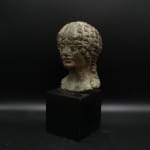Roman Bronze Bust, 3rd-4th century CE
height 13 cm
height 5 1/8 in
height 5 1/8 in
LI.3203
Further images
-
(View a larger image of thumbnail 1
)

-
(View a larger image of thumbnail 2
)

-
(View a larger image of thumbnail 3
)

-
(View a larger image of thumbnail 4
)

-
(View a larger image of thumbnail 5
)

-
(View a larger image of thumbnail 6
)

-
(View a larger image of thumbnail 7
)

-
(View a larger image of thumbnail 8
)

-
(View a larger image of thumbnail 9
)

A stunning example of female head (protome) in bronze dating to the late Roman imperial period (3rd to 4th centuries). Bronze was exceptionally precious in antiquity and was used regularly...
A stunning example of female head (protome) in bronze dating to the late Roman imperial period (3rd to 4th centuries). Bronze was exceptionally precious in antiquity and was used regularly for sculptures from the Archaic period onward, it was indeed the material in which most ancient sculptures were made, although very few survive. This sculpture was realised with the lost wax technique, a method of metal casting in which a molten metal is poured into a mold that has been created by means of a wax model covered in clay. Once the mold is made, the wax model is melted and drained away.
The woman is represented looking ahead, with heavy, globular hair with simple finger-sized waves with a simple center parting. This hairstyle was made popular in the Roman empire by the empress Julia Domna (Roman empress from 193 to 211 as the wife of Emperor Septimius Severus), who was the daughter of a high-ranking priest from Syria, and it has been suggested that her style was indicative of her foreign origins. Foreign women often wore their hair differently from Roman women, and women from Palmyra typically wore their hair waved in a simple center-parting. The eyes are heavily lidded and the mouth fleshy and slightly curved downwards.
This is an attractive piece of Roman art befitting the most discerning collectors.
The woman is represented looking ahead, with heavy, globular hair with simple finger-sized waves with a simple center parting. This hairstyle was made popular in the Roman empire by the empress Julia Domna (Roman empress from 193 to 211 as the wife of Emperor Septimius Severus), who was the daughter of a high-ranking priest from Syria, and it has been suggested that her style was indicative of her foreign origins. Foreign women often wore their hair differently from Roman women, and women from Palmyra typically wore their hair waved in a simple center-parting. The eyes are heavily lidded and the mouth fleshy and slightly curved downwards.
This is an attractive piece of Roman art befitting the most discerning collectors.








